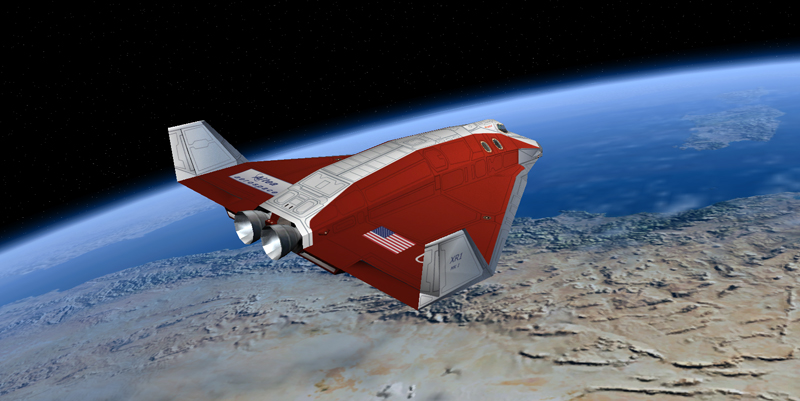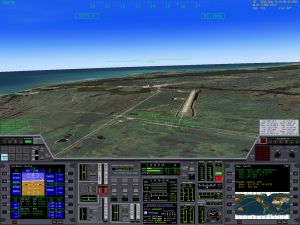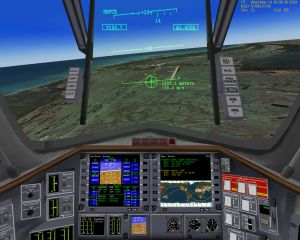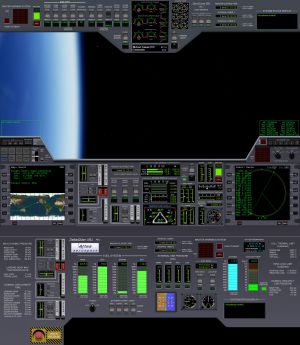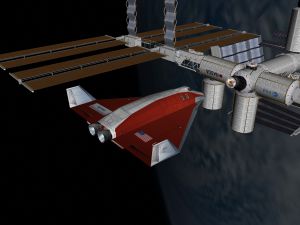DeltaGlider-XR1
The DeltaGlider-XR1 is a high-performance Spacecraft created for Orbiter by the Altea Aerospace team. The XR1's mesh and basic concept are based off of the DG-S included with Orbiter 2016, hover doors and scramjet doors added by Don Gallagher. Coding work to add multiple subsystems and failure modes was done by Douglas Beachy, as with other vessels in the XR series. The initial 1.0 release came on May 14, 2007, and the most recent release is 1.15 on February 20, 2018.
Design Concept[edit]
The XR1 is designed as a single stage to orbit, reusable spaceplane able to carry up to 5 passengers to low Earth orbit and beyond. The exact design parameters for the XR1 are variable, depending on the preferences set by a user in the configuration file, but with realism settings set to their highest levels, the XR1 proves quite challenging to fly succesfully. Scramjet engines are typically used during the bulk of the ascent to orbit, providing orbital velocity in the high atmosphere before conventional rocket engines are used to provide the final orbital insertion.
Features[edit]
Current features of the XR1 include:
- A 2D instrument panel with native support for 1280-, 1600-, and 1920-pixel-wide video modes, set by the 2DPanelWidth parameter in the Config\DeltaGliderXR1Prefs.cfg file.
- All-new instrument panels at native 1280x1024, 1600x1200, or 1920x1200 resolutions with 24-bit color. The main panel is low-profile in the center for maximum visibility.
- Virtual cockpit similar to the standard DG-S VC.
- Realistic simulation of atmospheric reentry heating, hull breaches typically occuring after 8 seconds of reentry heat over maximums.
- Realistic simulation of Scramjet engine overheating and related damage.
- [CHEATCODES] support in the DeltaGliderXR1Prefs.cfg file that allowing users to directly set certain values such as the ship's mass, maximum engine thrust, fuel tank capacity, etc.
- Multi-Display-Area (MDA) touch screen on the main instrument panel with multiple modes for custom autopilots, hull temperatures, ship damage status, and other ships functions. Readouts are switcheable between degrees Celsius, Kelvin, and Fahrenheit by clicking an area on the MDA screen.
- Efficient Attitude Hold autopilot available to hold a given pitch/AOA and bank while minimizing yaw; typically used during reentry or to hold attitude while braking with hover engines in a vacuum. Autopilot can hold a stable reentry at 10x time acceleration and can operate at 100x in space.
- Efficient Descent Hold and Auto-Land autopilot able to hold a descent or ascent rate. Autopilot can auto-land With a frame rate of around 100 fps, at 80x time acceleration and can operate at 100x in space. This means that users can auto-land the XR1 even with an effective frame rate of only 1.25 frames per second, and you can hold a set ascent/descent rate with an effective frame rate of only one frame per second.
- Airspeed Hold autopilot able to effectively hold a given airspeed within 0.1 meters-per-second.
- Reentry Systems Check MDA mode allows users to verify that the ship is properly configured for reentry.
- A new pop-up data HUD listing all the new XR1 keyboard shortcut keys.
- Extensive damage and warning modeling including wing load limits, dynamic pressure and heat limits for different surfaces, and gear collapse on landing. Crew may be injured or killed by hard landings or crashes.
- Callouts for altitude, speed, damage, warning, system failure, and docking distances.
- Auxiliary Power Unit (APU) with limited fuel that is used to power hydraulic systems such as aerodynamic control surfaces, landing gear, and wheel brakes.
- APU and O2 consumables management with ship's mass being affected by LOX (Liquid Oxygen) and APU fuel masses in addition to other propellants and any crew members.
- Internal system coolant management. The Delta Gliders original radiator is now used to cool internal systems in the XR-1. Heating internal coolants beyond their limits will cause internal systems failure.
- Two pop-up mini-Heads up displays. Secondary HUDs are fully configurable, able shows flight data such as altitude, airspeed, and orbital elements in Metric and Imperial units. Tertiary HUD is used to show ship's status, damage, and warnings.
- Extensively tweaked flight model now allows realistic reentry at 40-degree AOA, while also fixing a particular unrealistic "floaty" feel to gliding and landing.
- Eliminated the nose-up push that the stock DG exhibits when accelerating. This allows the XR1 to be much more neutral than the stock DG in its handling.
- Redesigned SCRAM (Supersonic RAMJET) engines capable of operation up to around Mach 18. An experienced pilot can now reach LEO with most of the main engine fuel remaining or use both the SCRAM and main engines at full power accelerating into orbit at 2.5 G's when in a hurry. XR-1 Scramjet engines operate at peak efficiency at Mach 7-8.
- 238 sound effects and voice callouts requiring the OrbiterSound 3.5 by DanSteph.
- Self-starting Mission-Elapsed-Time (MET) timer plus two manual interval timers.
- Refueling and LOX resupply/dump support.
- Capable of fuel cross-feed between main and RCS tanks.
- Scenario editor support.
Reception[edit]
The initial release of the XR1 met with some criticism, but provided the code base from which all other XR vessels are be based. In spite of its high quality, the XR1 appears to not have attracted the same recognition as the XR-5, XR-2, and the DGIV, but is still considered a very solid addition to the Orbiter addon community.
The XR1's homepage is here: Doug's Orbiter Page
For additional details refer to the XR1 Flight Operations Manual
